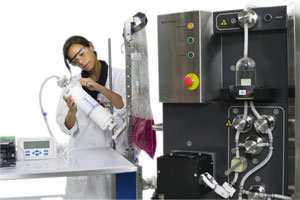Viewing Changes in Pharmaceutical Facility Design
Single-use systems, continuous processing and isolator technology use a smaller footprint. Experts predict how the facilities of the future may look much different than most today.
 Facilities in use today and built during the past decade would easily be recognised by the original engineers who started this industry in the mid-1970s, whereas facilities designed now are beginning to look different, most notably, significantly smaller. Whilst there is not much change in unit operations, there is a lot of optimisation resulting from system debottlenecking and lean activities.
Facilities in use today and built during the past decade would easily be recognised by the original engineers who started this industry in the mid-1970s, whereas facilities designed now are beginning to look different, most notably, significantly smaller. Whilst there is not much change in unit operations, there is a lot of optimisation resulting from system debottlenecking and lean activities.
In the past five years or so, single use (SU) approaches have brought about a significant change that will continue into the future as SU becomes more commonplace. SU has introduced a level of flexibility into facilities that was either unheard of or very expensive in a stainless-steel environment. Liquids can be pushed around in bags, thus removing the need for pipes and pumps, simplifying the facility and reducing engineering costs, for example. With stainless steel, duplicate equipment is needed to prepare one column step offline for the next campaign. With SU, however, new equipment is put in place with little preparation required.
In the next five to 10 years, SU adoption will be an ongoing trend. Some people, however, are still sceptical and would prefer to see the technology mature first. With technology development ongoing, prices are still relatively high and the supply chain has not been totally optimised, but in 10 years, SU will be more widely accepted.
In parallel, another change on the horizon in biopharmaceutical plants is continuous processing--the impact of which could be as significant in the pharmaceutical industry as it was in the car and electronic industries. Currently, facilities are active only for a part of their potential operating time. Operating 24 hours per day and 7 days per week will mean permanent occupancy of most equipment in a plant. Continuous processing will enable equipment in facilities to be smaller than today. With no waiting for cell growth and cell-culture bioreactors continuously operating, columns can be smaller than when they need to handle whole fermenter volumes at one time. Ultimately, the whole facility will be 50-60% smaller than today. Many people expect these developments but are waiting to see others adopt them and succeed before they decide to follow. This change, therefore, will be gradual over the coming decade or two.
About the Author
.jpg) Günter Jagschies, PhD, is senior director for Strategic Customer Relations, BioProcess at Cytiva.
Günter Jagschies, PhD, is senior director for Strategic Customer Relations, BioProcess at Cytiva.